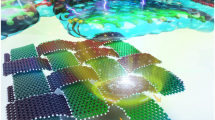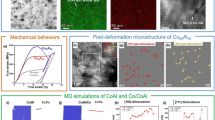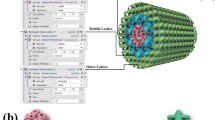Abstract
Ductile metals infiltrated with interconnected nanopores through selective dealloying gain useful properties but become macroscopically brittle due to flow localization. The mechanical behavior of nanoporous metals is dependent on a complex relationship between the deformation of the nanoporous foam structure and the deformation of the individual ligaments. Recent simulations and in situ experiments have revealed many insights into the deformation behavior of nanoporous metals, but it remains unclear how to engineer the structure to reduce flow localization. We perform transmission electron microscopy in situ tensile experiments on freestanding nanoporous gold films and observe the morphology evolution of both the interconnected structure and individual ligaments during deformation. Most ligaments fractured through plastic instability after large plastic elongation. We also observed several unexpected results such as instances of strain hardening and nanoscale brittle fracture in individual ligaments. Our observations suggest that highly curved ligaments and a wider distribution of ligament diameters could each contribute to ductility and fracture toughness.



Similar content being viewed by others
References
Wittstock A, Wichmann A, Biener J, Bäumer M (2011) Nanoporous gold: a new gold catalyst with tunable properties. Faraday Discuss 152:87–98. https://doi.org/10.1039/c1fd00022e
Ding Y, Chen M (2009) Nanoporous metals for catalytic and optical applications. MRS Bull 34:569–576. https://doi.org/10.1557/mrs2009.156
Lang X, Arai S, Guan P, Ishikawa Y, Fujita T, Tanaka N, Chen M, Zhang L, Hirata A, Erlebacher J, Tokunaga T, McKenna K, Yamamoto Y, Yamamoto Y, Asao N (2012) Atomic origins of the high catalytic activity of nanoporous gold. Nat Mater 11:775–780. https://doi.org/10.1038/nmat3391
Zhang X, Ding Y (2013) Unsupported nanoporous gold for heterogeneous catalysis. Catal Sci Technol 3:2862–2868. https://doi.org/10.1039/c3cy00241a
Kramer D, Viswanath RN, Weissmüller J (2004) Surface-stress induced macroscopic bending of nanoporous gold cantilevers. Nano Lett 4:793–796. https://doi.org/10.1021/nl049927d
Knoll W, Erlebacher J, Majoral J-P, Ahl S, Caminade A-M, Yu F (2006) Simultaneous excitation of propagating and localized surface plasmon resonance in nanoporous gold membranes. Anal Chem 78:7346–7350. https://doi.org/10.1021/ac060829h
Wittstock A, Biener J, Bäumer M (2010) Nanoporous gold: a new material for catalytic and sensor applications. Phys Chem Chem Phys 12:12919–12930. https://doi.org/10.1039/c0cp00757a
Lang X, Hirata A, Fujita T, Chen M (2011) Nanoporous metal/oxide hybrid electrodes for electrochemical supercapacitors. Nat Nanotechnol 6:232–236. https://doi.org/10.1038/nnano.2011.13
Xia R, Xu C, Wu W, Li X, Feng XQ, Ding Y (2009) Microtensile tests of mechanical properties of nanoporous Au thin films. J Mater Sci 44:4728–4733. https://doi.org/10.1007/s10853-009-3731-1
Gwak EJ, Jeon H, Song E, Kang NR, Kim JY (2018) Twinned nanoporous gold with enhanced tensile strength. Acta Mater 155:253–261. https://doi.org/10.1016/j.actamat.2018.06.009
Sun YE, Ye JIA, Minor AM, Balk TJ (2009) In situ indentation of nanoporous gold thin films in the transmission electron microscope. Microsc Res Tech 72:232–241. https://doi.org/10.1002/jemt.20676
Gibson LJ, Ashby MF (1982) The mechanics of three-dimensional cellular materials. Proc R Soc Lond A Math Phys Sci 382:43–59. https://doi.org/10.1098/rspa.1982.0088
Biener J, Hodge AM, Hamza AV, Hsiung LM, Satcher JH (2005) Nanoporous Au: a high yield strength material. J Appl Phys 97:2–5. https://doi.org/10.1063/1.1832742
Hodge A, Hayes J, Caro J, Biener J, Hamza A (2006) Characterization and mechanical behavior of nanoporous gold. Adv Eng Mater 8:853–857. https://doi.org/10.1002/adem.200600079
Jin HJ, Kurmanaeva L, Ro H, Ivanisenko Y, Schmauch J, Rösner H, Ivanisenko Y, Weissmüller J (2009) Deforming nanoporous metal : role of lattice coherency. Acta Mater C 57:2665–2672. https://doi.org/10.1016/j.actamat.2009.02.017
Badwe N, Chen X, Sieradzki K (2017) Mechanical properties of nanoporous gold in tension. Acta Mater 129:251–258. https://doi.org/10.1016/j.actamat.2017.02.040
Briot NJ, Kennerknecht T, Eberl C, Balk TJ (2014) Mechanical properties of bulk single crystalline nanoporous gold investigated by millimetre-scale tension and compression testing. Philos Mag 94:847–866. https://doi.org/10.1080/14786435.2013.868944
Balk TJ, Eberl C, Sun Y, Hemker KJ, Gianola DS (2009) Tensile and compressive microspecimen testing of bulk nanoporous gold. JOM 61:26–31. https://doi.org/10.1007/s11837-009-0176-6
Zheng H, Cao A, Weinberger CR, Huang JY, Du K, Wang J, Ma Y, Xia Y, Mao SX (2010) Discrete plasticity in sub-10-nm-sized gold crystals. Nat Commun 1:144–148. https://doi.org/10.1038/ncomms1149
Dou R, Derby B (2011) Deformation mechanisms in gold nanowires and nanoporous gold. Philos Mag 91:1070–1083. https://doi.org/10.1080/14786435.2010.481271
Sun XY, Xu GK, Li X, Feng XQ, Gao H (2013) Mechanical properties and scaling laws of nanoporous gold. J Appl Phys 113:023505. https://doi.org/10.1063/1.4774246
Sun Y, Ye J, Shan Z, Minor AM, Balk TJ (2007) The mechanical behavior of nanoporous gold thin films. JOM J Miner Met Mater Soc 59:54–58. https://doi.org/10.1007/s11837-007-0118-0
Lu Y, Song J, Huang JY, Lou J (2011) Fracture of Sub-20 nm ultrathin gold nanowires. Adv Funct Mater 21:3982–3989
Jiao J, Huber N (2017) Deformation mechanisms in nanoporous metals: effect of ligament shape and disorder. Comput Mater Sci 127:194–203. https://doi.org/10.1016/j.commatsci.2016.10.035
Hu K, Ziehmer M, Wang K, Lilleodden ET (2016) Nanoporous gold: 3D structural analyses of representative volumes and their implications on scaling relations of mechanical behaviour. Philos Mag 96:3322–3335. https://doi.org/10.1080/14786435.2016.1222087
Afanasyev K, Sansoz F, Afanasyev SF, Konstantin A (2007) Strengthening in gold-nanopillars with nanoscale twins. Nano Lett 7:2056–2062. https://doi.org/10.1021/nl070959l
Sun S, Chen X, Badwe N, Sieradzki K (2015) Potential-dependent dynamic fracture of nanoporous gold. Nat Mater 14:1–6. https://doi.org/10.1038/nmat4335
Liu P, Wei X, Song S, Wang L, Hirata A, Fujita T, Han X, Zhang Z, Chen M (2019) Time-resolved atomic-scale observations of deformation and fracture of nanoporous gold under tension. Acta Mater 165:99–108
Li R, Sieradzki K (1992) Ductile-brittle transition in random porous Au. Phys Rev Lett 68:1168–1171. https://doi.org/10.1103/PhysRevLett.68.1168
Sato K, Miyazaki H, Gondo T, Miyazaki S, Murayama M, Hata S (2016) Development of a novel straining holder for TEM compatible with electron tomography. In: 2016 Proceedings of European microscopy congress, Wiley, Hoboken, pp 287–288
Stuckner J, Frei K, McCue I, Demkowicz MJ, Murayama M (2017) AQUAMI: an open source python package and GUI for the automatic quantitative analysis of morphologically complex multiphase materials. Comput Mater Sci 139:320–329. https://doi.org/10.1016/j.commatsci.2017.08.012
Farkas D, Caro A, Bringa E, Crowson D (2013) Mechanical response of nanoporous gold. Acta Mater 61:3249–3256. https://doi.org/10.1016/j.actamat.2013.02.013
Crowson DA, Farkas D, Corcoran SG (2009) Mechanical stability of nanoporous metals with small ligament sizes. Scr Mater 61:497–499. https://doi.org/10.1016/j.scriptamat.2009.05.005
Warner DH, Curtin WA, Qu S (2007) Rate dependence of crack-tip processes predicts twinning trends in fcc metals. Nat Mater 6:876
Stuckner J, Frei K, Corcoran SG, Reynolds WT, Murayama M (under review) Assessing the influence of processing parameters and external loading on the nanoporous structure and morphology of nanoporous gold toward catalytic applications
Briot NJ, Balk TJ (2018) Focused ion beam characterization of deformation resulting from nanoindentation of nanoporous gold. MRS Commun 8:132–136. https://doi.org/10.1557/mrc.2017.138
Farkas D, Stuckner J, Umbel R, Kuhr B, Demkowicz MJ (2018) Indentation response of nanoporous gold from atomistic simulations. J Mater Res 33:1382–1390. https://doi.org/10.1557/jmr.2018.72
Acknowledgements
This work was sponsored by the NSF DMREF program under Grant Nos. #1623051 and #1533969. We acknowledge DOE BES Geosciences (DE-FG02-06ER15786) for developing the in situ TEM capability. Facilities were made available through Virginia Tech’s Institute for Critical Technology and Applied Science Nanoscale Characterization and Fabrication Laboratory (ICTAS-NCFL). We acknowledge Dr. Diana Farkas, Dr. William Reynolds, and Dr. Sean Corcoran for their expertise and insightful conversations. We also acknowledge the Virginia Tech National Center for Earth and Environmental Nanotechnology Infrastructure (NanoEarth), a member of the National Nanotechnology Coordinated Infrastructure (NNCI), supported by NSF (ECCS 1542100) for providing technical consultation.
Author information
Authors and Affiliations
Corresponding author
Ethics declarations
Conflict of interest
The authors are unaware of any conflicts of interest regarding the data and findings presented in this manuscript.
Additional information
Publisher's Note
Springer Nature remains neutral with regard to jurisdictional claims in published maps and institutional affiliations.
Electronic supplementary material
Below is the link to the electronic supplementary material.
Rights and permissions
About this article
Cite this article
Stuckner, J., Murayama, M. Mechanical properties of nanoporous gold subjected to tensile stresses in real-time, sub-microscopic scale. J Mater Sci 54, 12106–12115 (2019). https://doi.org/10.1007/s10853-019-03762-8
Received:
Accepted:
Published:
Issue Date:
DOI: https://doi.org/10.1007/s10853-019-03762-8




